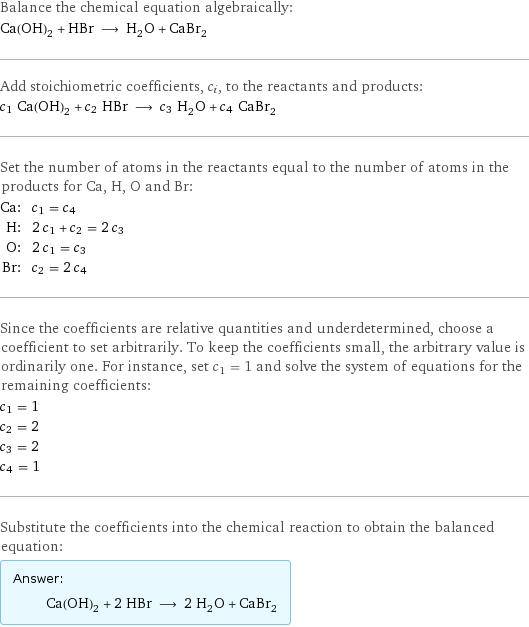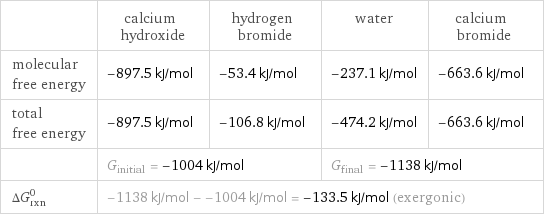Input interpretation

Ca(OH)_2 calcium hydroxide + HBr hydrogen bromide ⟶ H_2O water + CaBr_2 calcium bromide
Balanced equation

Balance the chemical equation algebraically: Ca(OH)_2 + HBr ⟶ H_2O + CaBr_2 Add stoichiometric coefficients, c_i, to the reactants and products: c_1 Ca(OH)_2 + c_2 HBr ⟶ c_3 H_2O + c_4 CaBr_2 Set the number of atoms in the reactants equal to the number of atoms in the products for Ca, H, O and Br: Ca: | c_1 = c_4 H: | 2 c_1 + c_2 = 2 c_3 O: | 2 c_1 = c_3 Br: | c_2 = 2 c_4 Since the coefficients are relative quantities and underdetermined, choose a coefficient to set arbitrarily. To keep the coefficients small, the arbitrary value is ordinarily one. For instance, set c_1 = 1 and solve the system of equations for the remaining coefficients: c_1 = 1 c_2 = 2 c_3 = 2 c_4 = 1 Substitute the coefficients into the chemical reaction to obtain the balanced equation: Answer: | | Ca(OH)_2 + 2 HBr ⟶ 2 H_2O + CaBr_2
Structures

+ ⟶ +
Names

calcium hydroxide + hydrogen bromide ⟶ water + calcium bromide
Reaction thermodynamics
Enthalpy

| calcium hydroxide | hydrogen bromide | water | calcium bromide molecular enthalpy | -985.2 kJ/mol | -36.3 kJ/mol | -285.8 kJ/mol | -682.8 kJ/mol total enthalpy | -985.2 kJ/mol | -72.6 kJ/mol | -571.7 kJ/mol | -682.8 kJ/mol | H_initial = -1058 kJ/mol | | H_final = -1254 kJ/mol | ΔH_rxn^0 | -1254 kJ/mol - -1058 kJ/mol = -196.7 kJ/mol (exothermic) | | |
Gibbs free energy

| calcium hydroxide | hydrogen bromide | water | calcium bromide molecular free energy | -897.5 kJ/mol | -53.4 kJ/mol | -237.1 kJ/mol | -663.6 kJ/mol total free energy | -897.5 kJ/mol | -106.8 kJ/mol | -474.2 kJ/mol | -663.6 kJ/mol | G_initial = -1004 kJ/mol | | G_final = -1138 kJ/mol | ΔG_rxn^0 | -1138 kJ/mol - -1004 kJ/mol = -133.5 kJ/mol (exergonic) | | |
Equilibrium constant
![Construct the equilibrium constant, K, expression for: Ca(OH)_2 + HBr ⟶ H_2O + CaBr_2 Plan: • Balance the chemical equation. • Determine the stoichiometric numbers. • Assemble the activity expression for each chemical species. • Use the activity expressions to build the equilibrium constant expression. Write the balanced chemical equation: Ca(OH)_2 + 2 HBr ⟶ 2 H_2O + CaBr_2 Assign stoichiometric numbers, ν_i, using the stoichiometric coefficients, c_i, from the balanced chemical equation in the following manner: ν_i = -c_i for reactants and ν_i = c_i for products: chemical species | c_i | ν_i Ca(OH)_2 | 1 | -1 HBr | 2 | -2 H_2O | 2 | 2 CaBr_2 | 1 | 1 Assemble the activity expressions accounting for the state of matter and ν_i: chemical species | c_i | ν_i | activity expression Ca(OH)_2 | 1 | -1 | ([Ca(OH)2])^(-1) HBr | 2 | -2 | ([HBr])^(-2) H_2O | 2 | 2 | ([H2O])^2 CaBr_2 | 1 | 1 | [CaBr2] The equilibrium constant symbol in the concentration basis is: K_c Mulitply the activity expressions to arrive at the K_c expression: Answer: | | K_c = ([Ca(OH)2])^(-1) ([HBr])^(-2) ([H2O])^2 [CaBr2] = (([H2O])^2 [CaBr2])/([Ca(OH)2] ([HBr])^2)](../image_source/f8cac018390c7c12bdae7b295860981e.png)
Construct the equilibrium constant, K, expression for: Ca(OH)_2 + HBr ⟶ H_2O + CaBr_2 Plan: • Balance the chemical equation. • Determine the stoichiometric numbers. • Assemble the activity expression for each chemical species. • Use the activity expressions to build the equilibrium constant expression. Write the balanced chemical equation: Ca(OH)_2 + 2 HBr ⟶ 2 H_2O + CaBr_2 Assign stoichiometric numbers, ν_i, using the stoichiometric coefficients, c_i, from the balanced chemical equation in the following manner: ν_i = -c_i for reactants and ν_i = c_i for products: chemical species | c_i | ν_i Ca(OH)_2 | 1 | -1 HBr | 2 | -2 H_2O | 2 | 2 CaBr_2 | 1 | 1 Assemble the activity expressions accounting for the state of matter and ν_i: chemical species | c_i | ν_i | activity expression Ca(OH)_2 | 1 | -1 | ([Ca(OH)2])^(-1) HBr | 2 | -2 | ([HBr])^(-2) H_2O | 2 | 2 | ([H2O])^2 CaBr_2 | 1 | 1 | [CaBr2] The equilibrium constant symbol in the concentration basis is: K_c Mulitply the activity expressions to arrive at the K_c expression: Answer: | | K_c = ([Ca(OH)2])^(-1) ([HBr])^(-2) ([H2O])^2 [CaBr2] = (([H2O])^2 [CaBr2])/([Ca(OH)2] ([HBr])^2)
Rate of reaction
![Construct the rate of reaction expression for: Ca(OH)_2 + HBr ⟶ H_2O + CaBr_2 Plan: • Balance the chemical equation. • Determine the stoichiometric numbers. • Assemble the rate term for each chemical species. • Write the rate of reaction expression. Write the balanced chemical equation: Ca(OH)_2 + 2 HBr ⟶ 2 H_2O + CaBr_2 Assign stoichiometric numbers, ν_i, using the stoichiometric coefficients, c_i, from the balanced chemical equation in the following manner: ν_i = -c_i for reactants and ν_i = c_i for products: chemical species | c_i | ν_i Ca(OH)_2 | 1 | -1 HBr | 2 | -2 H_2O | 2 | 2 CaBr_2 | 1 | 1 The rate term for each chemical species, B_i, is 1/ν_i(Δ[B_i])/(Δt) where [B_i] is the amount concentration and t is time: chemical species | c_i | ν_i | rate term Ca(OH)_2 | 1 | -1 | -(Δ[Ca(OH)2])/(Δt) HBr | 2 | -2 | -1/2 (Δ[HBr])/(Δt) H_2O | 2 | 2 | 1/2 (Δ[H2O])/(Δt) CaBr_2 | 1 | 1 | (Δ[CaBr2])/(Δt) (for infinitesimal rate of change, replace Δ with d) Set the rate terms equal to each other to arrive at the rate expression: Answer: | | rate = -(Δ[Ca(OH)2])/(Δt) = -1/2 (Δ[HBr])/(Δt) = 1/2 (Δ[H2O])/(Δt) = (Δ[CaBr2])/(Δt) (assuming constant volume and no accumulation of intermediates or side products)](../image_source/c47de502eca2679c7cb99d650eede94b.png)
Construct the rate of reaction expression for: Ca(OH)_2 + HBr ⟶ H_2O + CaBr_2 Plan: • Balance the chemical equation. • Determine the stoichiometric numbers. • Assemble the rate term for each chemical species. • Write the rate of reaction expression. Write the balanced chemical equation: Ca(OH)_2 + 2 HBr ⟶ 2 H_2O + CaBr_2 Assign stoichiometric numbers, ν_i, using the stoichiometric coefficients, c_i, from the balanced chemical equation in the following manner: ν_i = -c_i for reactants and ν_i = c_i for products: chemical species | c_i | ν_i Ca(OH)_2 | 1 | -1 HBr | 2 | -2 H_2O | 2 | 2 CaBr_2 | 1 | 1 The rate term for each chemical species, B_i, is 1/ν_i(Δ[B_i])/(Δt) where [B_i] is the amount concentration and t is time: chemical species | c_i | ν_i | rate term Ca(OH)_2 | 1 | -1 | -(Δ[Ca(OH)2])/(Δt) HBr | 2 | -2 | -1/2 (Δ[HBr])/(Δt) H_2O | 2 | 2 | 1/2 (Δ[H2O])/(Δt) CaBr_2 | 1 | 1 | (Δ[CaBr2])/(Δt) (for infinitesimal rate of change, replace Δ with d) Set the rate terms equal to each other to arrive at the rate expression: Answer: | | rate = -(Δ[Ca(OH)2])/(Δt) = -1/2 (Δ[HBr])/(Δt) = 1/2 (Δ[H2O])/(Δt) = (Δ[CaBr2])/(Δt) (assuming constant volume and no accumulation of intermediates or side products)
Chemical names and formulas

| calcium hydroxide | hydrogen bromide | water | calcium bromide formula | Ca(OH)_2 | HBr | H_2O | CaBr_2 Hill formula | CaH_2O_2 | BrH | H_2O | Br_2Ca name | calcium hydroxide | hydrogen bromide | water | calcium bromide IUPAC name | calcium dihydroxide | hydrogen bromide | water | calcium dibromide